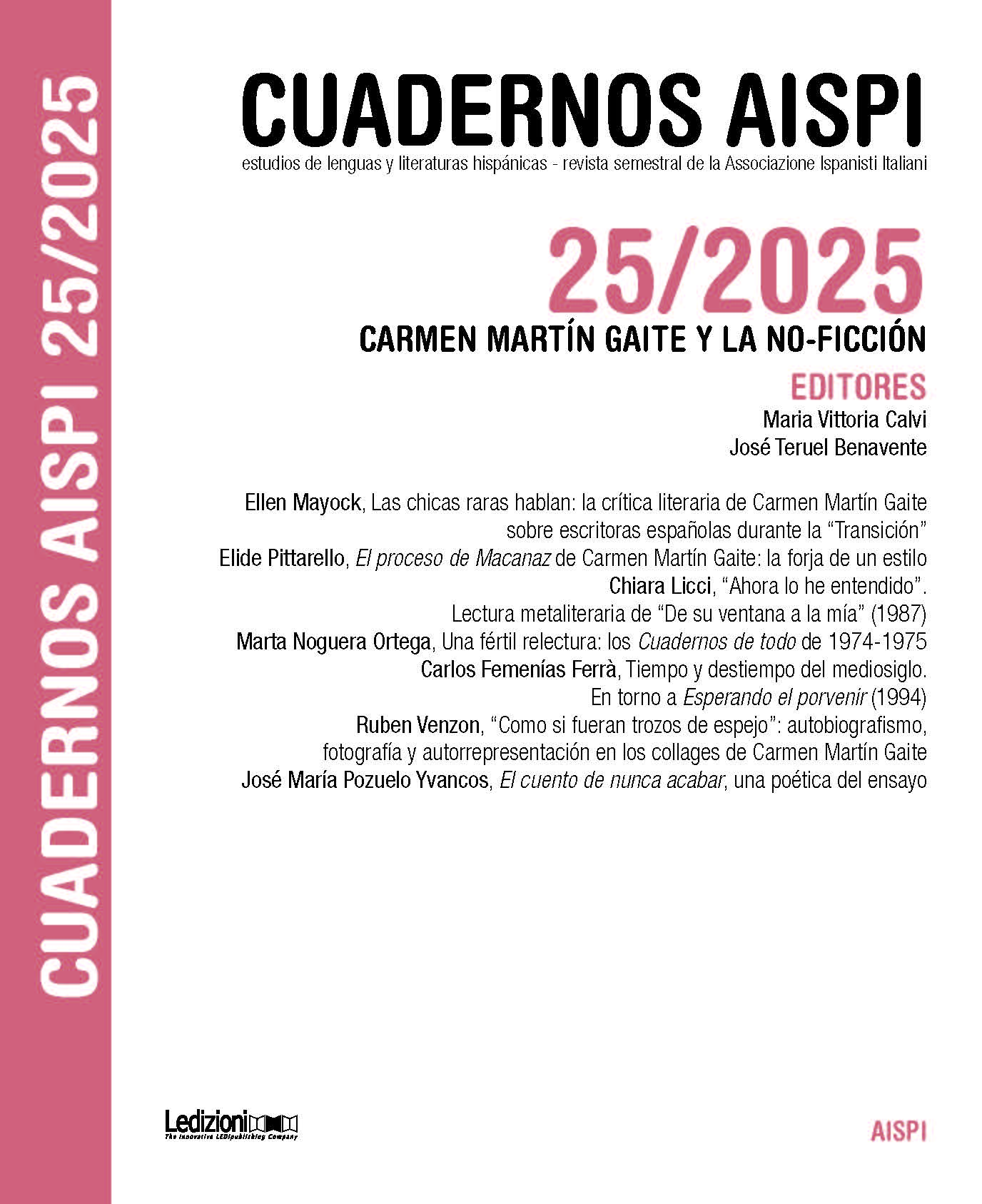City and public space in the poetry of the mid-century: Ángel González, Carmen Martín Gaite and María Beneyto
DOI:
https://doi.org/10.14672/1.2025.2981Keywords:
spain, poetry, “mid-century”, city, urban poetryAbstract
The work proposes to study the poetic work of three central authors of the so-called “Spanish mid-century” –Ángel González, María Beneyto and Carmen Martín Gaite– whose centenary of birth is commemorated this year. In their productions it is possible to observe different modulation around spaces and the relationship of the poetic subject with the diverse territories that it inhabits and poetizes. From the “urban landscapes” of the Asturian, which determine a matrix of urban poetry that runs through his poetry collections in a historicist key, both as a testimonial and ironic one; passing through the suffocating interior and provincial worlds that clearly mark the initial poems of Martín Gaite and end up in the New York city as a site of identity searches; to the vein of urban poetry that renews in Beneyto’s work the plural facets of the subject that determined her early work, and turns towards the city, its actors and spaces most relegated in the social line of her production. Movements and displacements that concern both his and her poetic sayings and the place of the author and the female authors in the sociological map, determining their figures as writers in the literary field and, in the case of Beneyto and Martín Gaite, their place as women and as poets in the complex post-war cultural field.
Downloads
References
Augé, Marc (1994), Los no lugares, Espacios del anonimato, Gedisa.
Bajtin, Mijail (1989), Teoría y estética de la novela, Madrid, Taurus.
Balcells, José María (2009), “Del término poetisa: aceptaciones y repulsas”, Voces del margen: mujer y poesía en España: siglo XX, León, Univ. de León, Área de Publicaciones: 11-20.
Beneyto, María (1956), Poemas de la ciudad, Barcelona, Joaquín Horta editor.
Beneyto, María (1976), Poesía. 1947-1964, Barcelona, Plaza&Janés.
Cañas, Dionisio (1990), “La poesía de la ciudad en Jaime Gil de Biedma”, Ínsula, julio-agosto, 523-524: 47-48.
Castellet, José María (1956), “Prólogo” a M. Beneyto, Poemas de la ciudad, Barcelona, Horta: 9-12.
De Lauretis, Teresa (1987), Technologies of Gender. Essays on Theory, film and Fiction, Londres, Macmillan Press.
De Luis, Leopoldo (2000) [1965], Poesía social española contemporánea. Antología (1939-1968), edición de Fanny Rubio y Jorge Urrutia, Madrid, Biblioteca Nueva.
Fernández Menéndez, Raquel (2021), “El antólogo como autor y la interpretación de las obras escritas por mujeres: Lecturas firmadas de J. M. Castellet”, Revista Chilena de Literatura, 103: 429-454.
García Canclini, Néstor (2007), Imaginarios Urbanos, Buenos Aires, Eudeba.
García Montero, Luis (2002), “Conversación con Ángel González”, Litoral. Ángel González. Tiempo inseguro, 233, ed. Susana Rivera, Málaga, junio: 14-27.
Gatell, Angelina (2006), Mujer que soy. La voz femenina en la poesía social y testimonial en los años cincuenta, Madrid, Bartleby.
Gilbert, Sandra M. y Susan Gubar (1998), La loca del desván. La escritora y la imaginación literaria del siglo XIX, Madrid, Cátedra.
González, Ángel (2010), Palabra sobre palabra (Obra completa), Barcelona, Seix-Barral.
Jitrik, Noé (1994), “Voces de ciudad”. SyC, 4, marzo, Buenos Aires: 7-18.
Jurado Morales, José (2018), Carmen Martín Gaite, el juego de la vida y la literatura, Madrid, Visor.
Kamenszain, Tamara (2020), “Las nuevas poetisas del siglo XXI”, Historia feminista de la literatura argentina, eds. L. Arnés, N. Domínguez y M. Punte, Villa María, Eduvim: 461-466.
Leuci, Verónica (2018), Poetas in-versos: ficción y nombre propio en Gloria Fuertes y Ángel González, Villa Marí, Eduvim.
Maingueneau, Dominique (2015), “Escritor e imagen de autor”, Tropelías, 24: 17-30.
Manegat, Julio (1976), “Prólogo”, M. Beneyto, Poesía. 1947-1964, Barcelona, Plaza&Janés: 13-33.
Martín Gaite, Carmen (1987a), Desde la ventana. Enfoque femenino de la literatura española. Espasa.
Martín Gaite, Carmen (1987b), Usos amorosos de la postguerra española, Anagrama.
Martín Gaite, Carmen (1993), Después de todo. Poesía a rachas, Hiperión.
Martin Gaite, Carmen (2023), A rachas. Poesía reunida. Edición de José Teruel, Barcelona, La Bella Varsovia.
Merlo, Pepa ed. (2010), “Concha Méndez”, “Peces en la tierra”. Antología de mujeres poetas en torno a la Generación del 27, Sevilla, Fundación José Manuel Lara.
Molinero, Carme (1998), “Mujer, franquismo, fascismo. La clausura forzada en un ‘mundo pequeño’”, Historia Social, 30, Franquismo: 97-117.
Payeras Grau, María (2009), Espejos de palabra. La voz secreta de la mujer en la poesía española de posguerra (1939-1959), Madrid, UNED.
Paz, Octavio (1983), “Poesía e historia”, Sombras de obras, Barcelona, Seix Barral.
Pérez Fontdevila, Aina y Torras Francès, Meri (eds.) (2019), ¿Qué es una autora? Encrucijadas entre género y autoría, Barcelona, Icaria.
Piña, Cristina (1993), “Los géneros fingidos”. Coloquio Carmen Martin Gaite, Buenos Aires, Instituto de Cooperación Iberoamericana: 49-54.
Scarano, Laura (2002), “Los paisajes urbanos de Ángel González”, Litoral. Ángel González. Tiempo inseguro, 33: 293-299.
Showalter, Elaine (2010), “La crítica feminista en el desierto”, Textos de teorías y crítica literarias:(del formalismo a los estudios postcoloniales), coord. por Nara Araújo, Teresa Delgado: 381-404.
Sinués de Marco, María del Pilar (1862), El ángel de hogar [28/01/2024]. https://www.cervantesvirtual.com/obra/el-angel-del-hogar-estudio-tomo-primero--0/
Teruel, José (2007), “La expresión poética en Carmen Martín Gaite”, Turia. Revista cultural, núm. 83, 2007: 236-45.
Torre Fica, Iñaki (2001), “‘La mujer ventanera’ en la poesía de Carmen Martin Gaite”, Revista Espéculo, 19: 67-75.
Villanueva, Darío (2004), Teorías del realismo literario, Madrid, Biblioteca Nueva.
Westphal, Bertrand (2011), Geocriticism. Real and fictional Spaces (trad. Robert Tally Jr), New York, Palgrave Macmillan.
Downloads
Published
Issue
Section
License

This work is licensed under a Creative Commons Attribution-NonCommercial-NoDerivatives 4.0 International License.
La revista está publicada bajo la licencia Creative Commons CC-BY.




